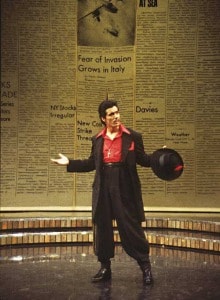 The relationship between the not-for-profits and the commercial sector started out contentiously. The First American Congress of Theatre, organized by the American Theatre Wing in 1974, was, by all accounts, a chair-throwing affair. “I had my own confrontation with the Shuberts after a session,” remembers Luis Valdez, the founder of El Teatro Campesino and writer-director of Zoot Suit, which landed on Broadway with commercial backing in 1979. “I was saying, ‘Broadway is irrelevant to me, and to all the other people here who don’t aspire to get there, and don’t believe we’ll ever get there. So why does it matter to me whether Broadway lives or dies?’ We had,” he concludes with mischievous understatement, “quite an animated discussion.”
The relationship between the not-for-profits and the commercial sector started out contentiously. The First American Congress of Theatre, organized by the American Theatre Wing in 1974, was, by all accounts, a chair-throwing affair. “I had my own confrontation with the Shuberts after a session,” remembers Luis Valdez, the founder of El Teatro Campesino and writer-director of Zoot Suit, which landed on Broadway with commercial backing in 1979. “I was saying, ‘Broadway is irrelevant to me, and to all the other people here who don’t aspire to get there, and don’t believe we’ll ever get there. So why does it matter to me whether Broadway lives or dies?’ We had,” he concludes with mischievous understatement, “quite an animated discussion.”
By 2000, when Theatre Communications Group and the League of American Theatres and Producers (now the Broadway League) organized a second conference on the subject, tempers had cooled considerably. “The tenor in the room was, ‘We have to do these things, we can’t survive without them,’” says Diane Ragsdale, the former Mellon Foundation staffer and current academic studying the evolving interactions of the nonprofit and the commercial world.
Ragsdale literally wrote the book on the most recent forum convened on the topic, a 2011 gathering at Arena Stage organized by the Center for the Theater Commons. Her report “In the Intersection” details each session of the two-day event, including a conversation between Gregory Mosher, former artistic director of Lincoln Center Theater, and Landesman, who, in a 1988 editorial in the New York Times, famously took Mosher to task for what he saw as LCT’s unfair and unethical incursion into the Broadway world.
Mosher defended LCT and its success with projects such as Sarafina and Speed-the-Plow (starring Madonna), but now acknowledges that Landesman had a point.
“Rocco intuited that not-for-profits might want to pursue the end result LCT had accomplished—the long runs, the televised awards, the buzz, the occasional cash infusion—and that once you get those things, it’s almost impossible to give them up,” Mosher says. “What I couldn’t see then was that a theatre might, understandably, take shortcuts, such as casting stars, or choosing plays deemed to be more likely of success, in order to feed the habit. When this happens, the not-for-profit management may or may not have abandoned the not-for-profit’s sacred and legal mission, which is to create art.”
The lure of Broadway, Tonys and the kind of cash that a megahit like A Chorus Line can yield are powerful enticements, and nonprofits of all stripes acknowledge they can cloud the judgment of staff, board members and artists alike. But those theatremakers point out that not-for-profits now exist in a changed world: Not only has the government funding that helped kickstart the nonprofit movement dried up, but a major cultural shift in the last 30 years has seen the market economy triumph over the alternative ethos of the 1960s, when an existence outside the marketplace had real cachet. In this atmosphere, commercial partnerships are one significant avenue down which a not-for-profit can turn.
“The world of Rockefeller-era budgets for the arts has disappeared, but the not-for-profits are still here,” says Samuels Foundation president Robert Marx, who has watched the funding landscape change in a career that also encompasses time at the New York State Council on the Arts. “You still have to meet payroll. You still have to keep your institution alive. But there’s always this lingering question.”

